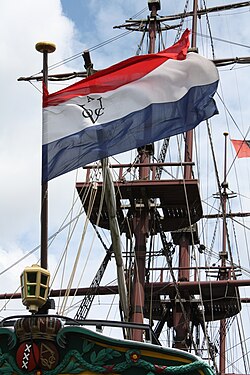 |
Love.az |
Niderland Ost-Hind Şirkəti, rəsmi olaraq Birləşmiş Ost-Hind Şirkəti (nid. Vereenigde Oostindische Compagnie; VOC), 17-ci əsrin əvvəllərində bir neçə rəqib holland ticarət şirkətinin (voorcompagnieën) hökumət tərəfindən yönəldilmiş və birləşməsi ilə qurulmuş erkən meqakorporasiya idi.[1][2] Proto-sənayeləşmə dövründə [3] Muğal Hindistanı ilə ticarət etmək üçün qurulmuş bir şirkət olaraq 20 mart 1602-ci ildə yaradıldı.[4] Əsasən də ən inkişaf etmiş Benqal Subah olaraq bilinən bölgədən 50% -i toxuculuq və 80% ipək idxal edildi.[5][6][7][8][9]
| Niderland Ost-Hind Şirkəti | |
|---|---|
| |
 | |
 | |
| Ümumi məlumatlar | |
| Ölkə | Niderland |
| Yaradılma tarixi | 20 mart 1602 |
| Əvvəlki qurum |
Voorcompagnieën
|
| Ləğv edilib | 31 dekabr 1799 |
| Tabelik | Yeddi Birləşmiş Əyalət Respublikası |
| Ünvan | Oost-Indiş Huis,Amsterdam (qlobal), Batavia (xaricdə) |
| Rəhbərlik | |
| Rəhbər | İohan van Oldenbarnevelt |



Bengal [...] was rich in the production and export of grain, salt, fruit, liquors and wines, precious metals and ornaments besides the output of its handlooms in silk and cotton. Europe referred to Bengal as the richest country to trade with.
Anup Shah (2002): "Today we know that corporations, for good or bad, are major influences on our lives. For example, of the 100 largest economies in the world, 51 are corporations while only 49 are countries, based on a comparison of corporate sales and country GDPs. In this era of globalization, marginalized people are becoming especially angry at the motives of multinational corporations, and corporate-led globalization is being met with increasing protest and resistance. [...]"
| Vikimənbədə bu mətnin orijinalı var. Bax: Octrooi van de VOC |